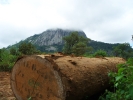 The multibillion-dollar effort to plant a 5,000-kilometer-long wall of trees failed. A Great Green Wall of trees 10 kilometers wide and 5,000 kilometers long, bisecting a dozen countries from Senegal in the west to Djibouti in the east. Planting trees across the Sahel, the arid savanna on the south border of the Sahara Desert, had no chance to succeed. There was little funding. There was no science suggesting it would work. Moreover, the desert was not actually moving south; instead, overuse was denuding the land. Large chunks of the proposed "wall" were uninhabited, meaning no one would be there to care for the saplings.
The multibillion-dollar effort to plant a 5,000-kilometer-long wall of trees failed. A Great Green Wall of trees 10 kilometers wide and 5,000 kilometers long, bisecting a dozen countries from Senegal in the west to Djibouti in the east. Planting trees across the Sahel, the arid savanna on the south border of the Sahara Desert, had no chance to succeed. There was little funding. There was no science suggesting it would work. Moreover, the desert was not actually moving south; instead, overuse was denuding the land. Large chunks of the proposed "wall" were uninhabited, meaning no one would be there to care for the saplings.
"If all the trees that had been planted in the Sahara since the early 1980s had survived, it would look like Amazonia," says Chris Reij, of the World Resources Institute. who has been working in Africa since 1978. "Essentially 80 percent or more of planted trees have died."
Reij and other scientists working on the ground knew that farmers in Niger and Burkina Faso, in particular, had discovered a cheap, effective way to regreen the Sahel. They did so by using simple water harvesting techniques and protecting trees that emerged naturally on their farms.
Slowly, the idea of a Great Green Wall has changed into a program centered around indigenous land use techniques, not planting a forest on the edge of a desert. The African Union, FAO and the World Bank now refer to it as "Africa’s flagship initiative to combat land degradation, desertification and drought.
The Sahel spans 3,360 miles from the Atlantic Ocean to the Indian Ocean, a belt stretching across the southern edge of the Sahara. Rainfall is low, from four to 24 inches per year, and droughts are frequent. Climate change means greater extremes of rainfall as the population skyrockets in the region, one of the poorest in the world. Food security is an urgent concern. By 2050, the population could leap to 340 million, up from 30 million in 1950 and 135 million today.
Reij began working in the Sahel when the soil literally was blowing away during dust storms. After years away, Reij returned to Niger and Burkina Faso in the summer of 2004. He was stunned by what he saw, green where there had been nothing but tan, denuded land. He quickly secured funding for the first of several studies looking at farming in villages throughout Burkina Faso and Niger. Hundreds of thousands of farmers had embraced ingenious modifications of traditional agriculture practices, transforming large swaths into productive land, improving food and fuel production for about 3 million people.
Farmers in the Sahel had learned from French colonists to clear land for agriculture and keep crops separate from trees. Under French colonial law and new laws that countries adopted after independence, any trees on a farmer's property belonged to the government. Farmers who cut down a tree for fuel would be threatened with jail. The idea was to preserve forests; it had the opposite effect. This was a terrific negative incentive to have a tree, and for years and years, tree populations were declining.
Reij says that by 2011, there were more than 12 million acres restored in Niger alone. More than 1.2 million were restored in Mali, but no one knew until 2010 because no one looked. The key, Reij says, is scaling up the effort in the drylands countries by building up grassroots efforts, addressing the legal issues (like tree ownership), and creating markets for the products of agroforestry. "We've never seen anything near this size and impact on the environment anywhere in west Africa," Tappan adds. "In our mind Niger already has its great green wall. It's only a matter of scaling it up."


